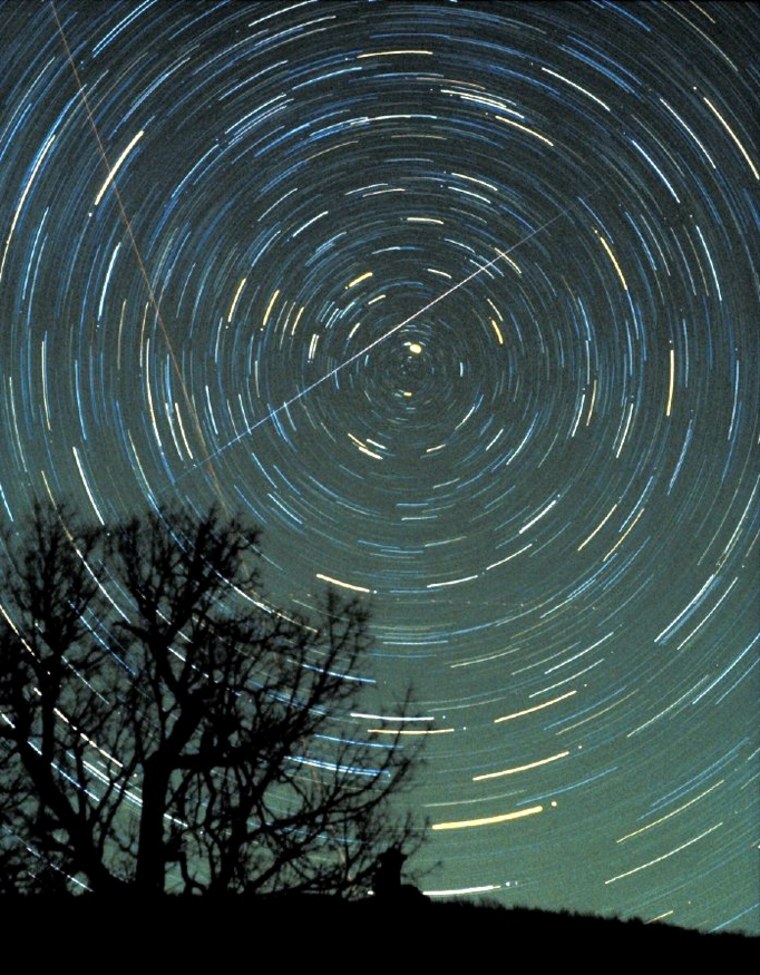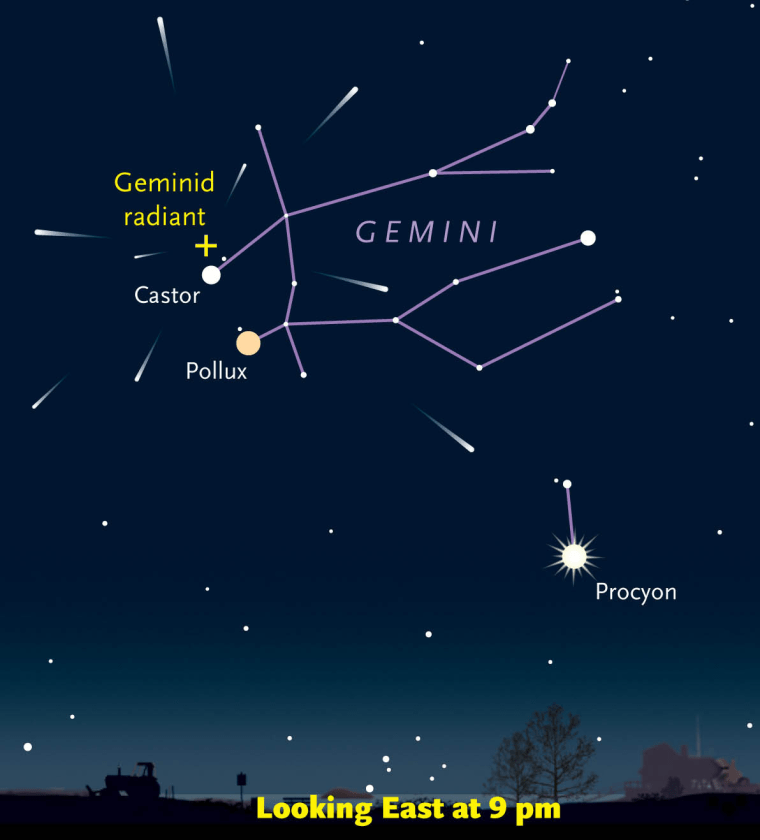
December isn't exactly prime time for sitting out in the cold and dark, but tonight could be the exception: The most productive meteor shower of the year is due to reach its peak tonight. Don't just take it from me -- you can ask the experts yourself during a series of online chats building up to the Geminid meteor shower.
There's lots that's appealing about this year's Geminids: Astronomers say the shooting stars could be spotted at a rate of more than one per minute under peak conditions (the equivalent of 60 to 120 per hour). The moon is in its first-quarter phase, meaning that it'll be setting around midnight and won't be glaring in the sky during the peak viewing hours (midnight to morning twilight). Earth is projected to pass through the thickest part of the meteor debris stream during the wee hours of the morning for North Americans, who are in just about the best position to see the maximum flash.
So what's the problem? Why aren't the Geminids as highly anticipated and well-known as the Perseids of August or the Leonids of November. Well, the biggest drawback is that it's c-c-c-cold out there this time of year. That means it's more important than ever to bundle up, have a comfortable lounge chair and sleeping bag at the ready, and bring along hot beverages to keep warm.

The best viewing is available far from the glare of city lights, where you have an unobstructed view of as much of the sky as possible. Geminid meteors are so named because they appear to emanate from a point in the constellation Gemini. But the shooting stars can appear anywhere in the sky, so don't just stare at Gemini. There's no need to gaze through binoculars, though you may want to take them along to see other celestial points of interest.
The early reviews are already streaming in, and it's a strong thumbs-up: Peak rates rose to as high as 40 meteors per hour last night, according to statistics gathered by the International Meteor Organization.
Exactly when and where should you go skywatching tonight? And what will you see? Three online tools can help you sort out those key questions:
- When? NASA's Fluxtimator is a Java-based online application that lets you specify your location, date, viewing conditions and the meteor shower you're interested in -- and then shows you how many meteors you could expect to see. Today, it's telling me that I might spot 80 meteors per hour at 1 a.m. PT if I'm in the countryside around the Seattle area. That's assuming that the skies are clear.
- Where? The Clear Sky Chart is a fantastic database that gathers up weather data for skywatching hot spots in the United States, Canada and parts of Mexico, and translates all those readings into graphical charts showing you what to expect at a particular location, hour by hour. You can get a quick read on whether it's likely to be cloudy or clear, what the atmospheric "seeing" conditions will be, and when dawn is due to start breaking. I can see already that the forecast is not that great for my favorite viewing spot, Rattlesnake Lake in the Cascade foothills.
- What's it all about? NASA's Marshall Space Flight Center has set up an online chat about the Geminids with meteor experts Danielle Moser and Rhiannon Blaauw. They can provide a preview of the event, advice for skywatching, and the science behind the meteor phenomenon. The main event starts at 11 p.m. ET, when NASA astronomer Bill Cooke presides over a late-night meteor chat. That's due to last until 5 a.m. ET.
One of the big mysteries surrounding the Geminids has to do with their origin. Annual meteor showers like the Perseids and Leonids are generally fueled by the gritty debris left behind by a comet that just happened to cross Earth's orbit. When those bits of rock hit the upper atmosphere at a speed of 22 miles per second, air friction causes them to vaporize -- leaving behind the glowing streaks we associate with shooting stars.
The weird thing about the Geminids is that it's thought to be caused by debris from an orbit-crossing asteroid rather than a comet. The asteroid Phaeton, to be precise. Astronomers have come around to the view that Phaeton may have started out as a classic comet but eventually lost its ice, leaving the rocky core we see today. The leading hypothesis is that Phaeton's rock becomes fractured due to thermal stresses when it passes close to the sun, and leaves behind fresh trails of debris during each orbit. But there are some things about that hypothesis that don't quite add up.
"The Geminids are my favorite, because they defy explanation," Cooke observed in a NASA preview that explains the mystery more fully.
For general advice about maximizing your viewing experience, review my top 10 meteor-watching tips from August. And if you miss tonight's show due to weather or holiday-season weariness, never fear: The Geminids are expected to provide encore performances through the next few nights. Then it'll be only a few more days until the next celestial extravaganza: the total lunar eclipse on Dec. 20-21.
Update for 1:10 p.m. ET: The MeteorWatch.org website is keeping track of meteor sightings around the world. To share your shooting-star reports via Twitter, just include the term #meteorwatch and your location in your tweet. That way they'll show up on this Meteor Map.
Update for 3 p.m. ET: NASA is using a Java-based client for the Geminids chat, so you'll have to have Java enabled in order to participate. The chatsters are getting lots of great questions, and I expect it will be the same tonight when Cooke is on the show. Starting this afternoon, you should be able to watch live video from Marshall Space Flight Center's "meteor-cam," via the same Web page used for the chat.
Got a celestial sighting to report? Share your skywatching experiences as a comment below. You can also connect with the Cosmic Log community by "liking" the log's Facebook page or following @b0yle on Twitter.